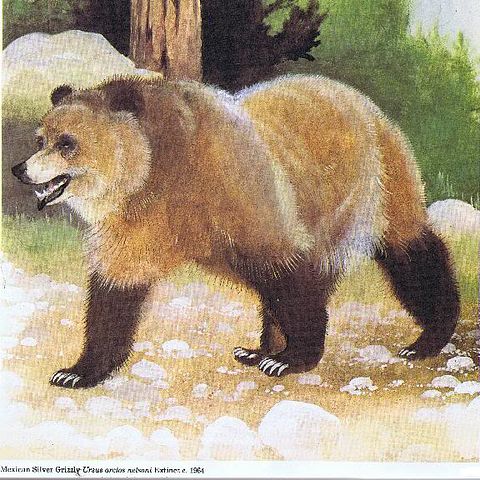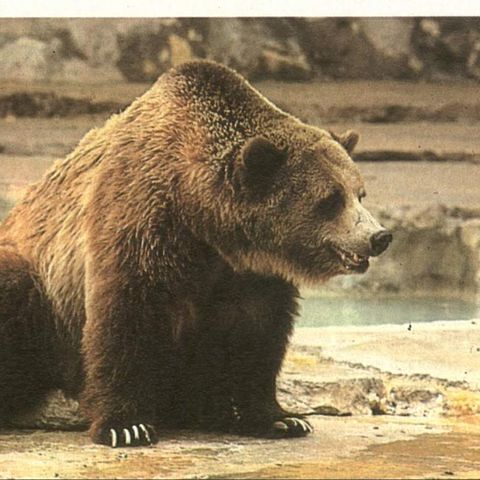Post by King Kodiak on Mar 12, 2019 17:33:23 GMT -5
MEXICAN GRIZZLY BEAR
The Mexican grizzly bear (Ursus arctos horribilis; formerly Ursus arctos nelsoni) is an extinct population of the grizzly bear in Mexico.
The holotype was shot by H. A. Cluff at Colonia Garcia, Chihuahua in 1899. The extinct California grizzly bear extended slightly south into Baja California. The bears in Durango, Chihuahua, Sonora and central Mexico were likely more related to the bears of Arizona, New Mexico and Texas than to those of California
Known in the Opatas language as the pissini, the Mexican grizzly bear was one of the heaviest and largest mammals in Mexico. It reached a length up to 1.82 m (6 ft 0 in) and an average weight of 318 kilograms (701 lb). Due to its silver fur it was often named el oso plateado (the silvery bear). The Mexican grizzly bear was smaller than the grizzly bears in the United States and Canada. The general color was pale buffy yellowish varying to grayish-white, grizzled from the darker color of the underfur. Specimens in worn pelage varied to yellowish-brown and reddish. The longest fur hairs were on the throat and the flanks. The belly was sparsely haired, lacking the thick underfur of the back and the flanks.
Range and habitat
The Mexican grizzly bear inhabited the northern territories of Mexico, in particular the temperate grasslands and mountainous pine forests. Its previous range reached from Arizona to New Mexico, Texas and Mexico.
Biology
Like all brown bears, Mexican grizzly bears were omnivores. Their diet mainly consisted of plants, fruits and insects and it is reported that it was very fond of ants, like most brown bears.[6][7] Occasionally it fed also on small mammals and carrion. Females produced one to three cubs every three years or so.[6]
Extinction
The first Europeans to come in contact with the Mexican grizzly bear were the conquistadors in the 16th century when Francisco Vásquez de Coronado went on an expedition to find the Seven Cities of Gold. His expedition began in Mexico City in 1540 and went north to New Mexico and the Buffalo Plains in the modern-day US states of Texas and Kansas.
Because the bears hunted the cattle from time to time, they were considered a pest by farmers. The Mexican grizzly bear was trapped, shot and poisoned and had already become scarce by the 1930s. Its former range decreased to the three isolated mountains Cerro Campana, Cerro Santa Clara, and Sierra del Nido 80 km north of Chihuahua in the state of Chihuahua. By 1960 only 30 of them were left. Despite its protected status, the hunting continued. By 1964 the Mexican grizzly bear was regarded as extinct.[6] After rumours of some surviving individuals on a ranch at the headwaters of the Yaqui River in the state of Sonora in 1968, American biologist Dr. Carl B. Koford went on a three-month survey but without success.[8] A grizzly was shot in 1976 in Sonora, the fourth confirmed in Sonora and the first in many decades.[9] The Mexican grizzly is now presumed to be extinct, or perhaps only extirpated.[10]
References
en.m.wikipedia.org/wiki/Mexican_grizzly_bear
The Mexican grizzly bear (Ursus arctos horribilis; formerly Ursus arctos nelsoni) is an extinct population of the grizzly bear in Mexico.
The holotype was shot by H. A. Cluff at Colonia Garcia, Chihuahua in 1899. The extinct California grizzly bear extended slightly south into Baja California. The bears in Durango, Chihuahua, Sonora and central Mexico were likely more related to the bears of Arizona, New Mexico and Texas than to those of California
Known in the Opatas language as the pissini, the Mexican grizzly bear was one of the heaviest and largest mammals in Mexico. It reached a length up to 1.82 m (6 ft 0 in) and an average weight of 318 kilograms (701 lb). Due to its silver fur it was often named el oso plateado (the silvery bear). The Mexican grizzly bear was smaller than the grizzly bears in the United States and Canada. The general color was pale buffy yellowish varying to grayish-white, grizzled from the darker color of the underfur. Specimens in worn pelage varied to yellowish-brown and reddish. The longest fur hairs were on the throat and the flanks. The belly was sparsely haired, lacking the thick underfur of the back and the flanks.
Range and habitat
The Mexican grizzly bear inhabited the northern territories of Mexico, in particular the temperate grasslands and mountainous pine forests. Its previous range reached from Arizona to New Mexico, Texas and Mexico.
Biology
Like all brown bears, Mexican grizzly bears were omnivores. Their diet mainly consisted of plants, fruits and insects and it is reported that it was very fond of ants, like most brown bears.[6][7] Occasionally it fed also on small mammals and carrion. Females produced one to three cubs every three years or so.[6]
Extinction
The first Europeans to come in contact with the Mexican grizzly bear were the conquistadors in the 16th century when Francisco Vásquez de Coronado went on an expedition to find the Seven Cities of Gold. His expedition began in Mexico City in 1540 and went north to New Mexico and the Buffalo Plains in the modern-day US states of Texas and Kansas.
Because the bears hunted the cattle from time to time, they were considered a pest by farmers. The Mexican grizzly bear was trapped, shot and poisoned and had already become scarce by the 1930s. Its former range decreased to the three isolated mountains Cerro Campana, Cerro Santa Clara, and Sierra del Nido 80 km north of Chihuahua in the state of Chihuahua. By 1960 only 30 of them were left. Despite its protected status, the hunting continued. By 1964 the Mexican grizzly bear was regarded as extinct.[6] After rumours of some surviving individuals on a ranch at the headwaters of the Yaqui River in the state of Sonora in 1968, American biologist Dr. Carl B. Koford went on a three-month survey but without success.[8] A grizzly was shot in 1976 in Sonora, the fourth confirmed in Sonora and the first in many decades.[9] The Mexican grizzly is now presumed to be extinct, or perhaps only extirpated.[10]
References
en.m.wikipedia.org/wiki/Mexican_grizzly_bear










